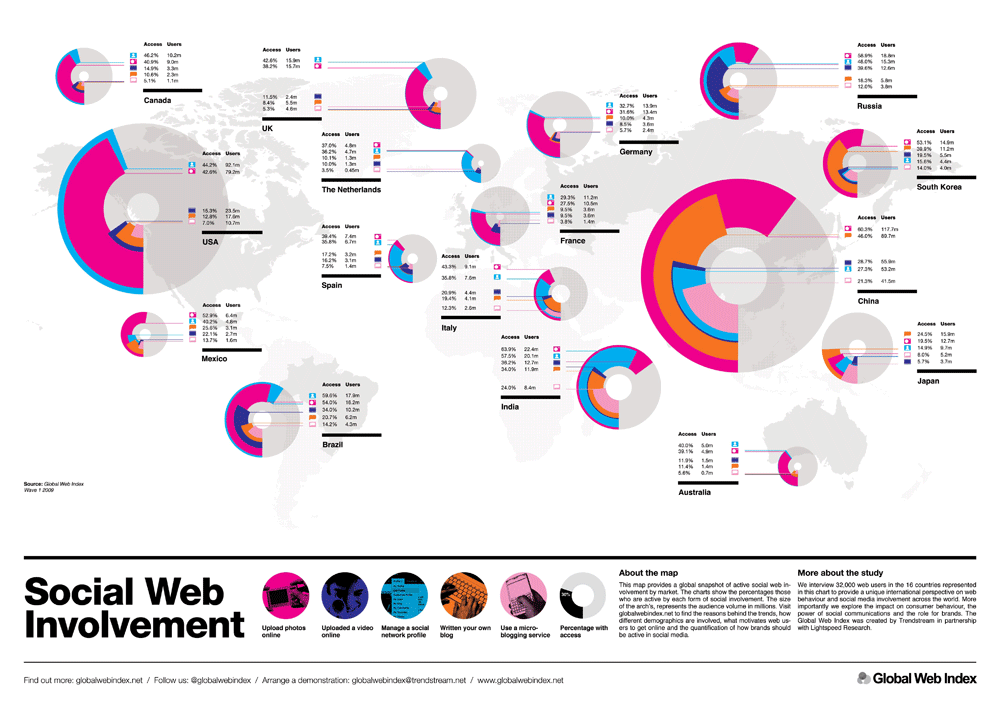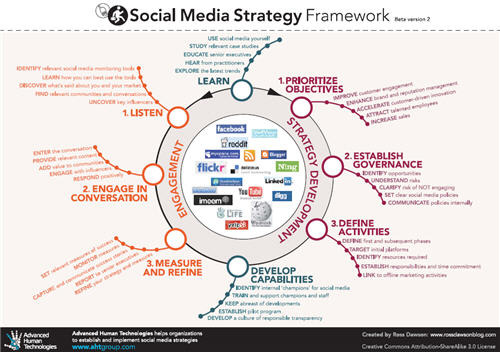To me it always seemed obvious why we called social software or social media the way we do. I have read a number of articles talking about dispersed knowledge workers who are collaborating via the Internet. But does it really have to be that sophisticated? In Niall’s book I found a small collection of activities that make the web social. This is how we derive the meaning. The former description is still correct, yet the activities named below better reflect our real world behavior.
A Global Map of Social Web Involvement by @globalwebindex
Above you can see a world map of social media involvement. The study was conducted by Trendstream, a research consultancy. The map shows the popularity of different social media services around the world. Trendstream provides total user numbers and the national penetration rates.
What’s the most common pattern of social media engagement?
- Managing a social network profile
- Uploading photos
- Uploading videos
- Writing a blog
- Using a microblogging service
It is interesting to note that managing social network profiles and uploading pictures seem to be the more common activities regarding social media engagement. Many countries have penetration rates approaching or even exceeding 50 percent. Uploading videos, writing blogs, and using microblogging services are clearly niche activities with the majority of adoption rates being well below 20 percent.
What seems to stand out?
- Japan’s low overall engagement is due to the high utilization of mobile devices, which have not been included, according to the authors. I feel this is a weakness of the study.
- India leads the table in terms of photo uploads.
- Brazil displays the highest rate of users maintaining social network profiles.
- Russia has the highest rate of video uploads.
- China counts the highest amount of bloggers.
I would be very interested in finding out why certain technologies are particularly popular in one country, but lag behind significantly in others. Why is blogging so popular in China? What’s the reason behind Brazil’s active usage of social networks? If you have any ideas or suggestions, please feel free to leave a comment or email me.
When Real-Time Isn’t Fast Enough by @jowyang
via ustream.tv
This is a video of Jeremiah Owyang, who is a Partner at the Altimeter Group, a strategy consulting firm. The other day he gave a presentation at LeWeb, Europe’s largest internet conference. The points that he makes are quite interesting. Below you can find a brief summary of my notes.
1) Start listening now, and quickly offer social personalization features
- Include contextual information based on social profiles
- Allow access to services such as FB connect, analyze behavior, and customize the product offers accordingly
2) Develop an unpaid army of advocates who can respond when you’re not there
- Work with customers and evangelists and use them as an unpaid R&D team
- Give them recognition and access to exclusive information, not cash
3) Start to invest in systems –like social CRM– that can support the overall strategy
- Integrative strategy counts; all customer data needs to be stored in one location
- Future: match Twitter and other accounts with trad. CRM systems and detect customer problems as they occur
If you would like to have a look at the entire presentation, check Jeremiah’s blog.
Social Media – A Visual Introduction
I am a very visual person. I like mindmaps, diagrams and other types of graphs to help me learn and understand. Below you will find a couple visualizations that I found particularly helpful in furthering my understanding of the social media scene. If you know of any other graphic representations, please do let me know. I would love to see them.
Social Media Strategy Framework by @rossdawson
I like the Social Media Strategy Framework because it focuses on objectives. What do you want to achieve? Do you want to listen to potential customers or better engage existing ones? Would you like to identify influencers and other key players in your market? You surely can do all of that but not every tools fits every pupose.



